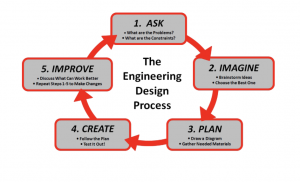What is the Maker Mindset?
Makerspaces are quickly finding a home in every school. Schools are remodeling media centers, industrial tech areas, and computer labs with technology and materials to provide students with the space and capability to make whatever they can think of while pursuing the Maker Mindset.
What is the Maker Mindset?
According to Dale Dougherty, founder of Make magazine, in “The Maker Mindset”
“Makers give it a try; they take things apart; and they try to do things that even the manufacturer did not think of doing. Whether it is figuring out what you can do with a 3D printer or an autonomous drone aircraft, makers are exploring what these things can do and they are learning as well. Out of that process emerge new ideas, which may lead to real-world applications or new business ventures. Making is a source of innovation.”
The Maker Mindset has many benefits for students. Making requires creativity, problem-solving, reflection, and perseverance. Students can work on projects alone or with others strengthening their ability to plan and work with others. Making facilitates innovation while providing students with the opportunity to work in a multi-disciplinary environment and tie their learning to the real world. The many aspects of making can help address differentiation and personalized learning while addressing the needs of different learning styles and multiple intelligences.
As students make, they participate in the Engineering Design Process which is the height of STEM learning. Making is a cyclical process where students ask questions, brainstorm possible answers, and create a plan for bringing those answers to life. These first steps happen a lot in school but Makerspaces allow students to take their learning to the next level as they now create the answer they imagined.
Typically students start by following their plan but improve their creation during the creation process as they see it come to life. Then the process starts again as students look to how they can continue to improve their creation.
There are many different types of supplies in a Makerspace both technology-based and more traditional supplies and consumables. The technology-based supplies tend to include things such as 3D printers, Makey Makeys, Little Bits, Cubelets, Arduinos and Raspberry Pi, and various types of robots from Bee Bots to Spheros and Lego Mindstorms. There are also recommended non-technology supplies such as hand tools, Legos, sewing materials, toothpicks, popsicle sticks, yarn, and cardboard. How do you stock your Makerspace? Grants are a great source of revenue. Some teachers use GoFundMe to get resources to pay for the more expensive supplies. Ask your parents and community for donations for the low-tech and consumable supplies. You will be surprised at what people have and are willing to donate.
Here are some resources to provide ideas for stocking your Makerspace:
100+ Makerspace Products and Materials
What’s in Your School’s Dream Makerspace?
Creating and stocking your Makerspace is the easy part, “build it and they will come” doesn’t always happen. Once you have your space you will want to get students excited to use the space and give teachers ideas of how students can use the Makerspace to demonstrate their learning in the classroom, this works best in a project-based learning environment. Getting students into the Makerspace is probably the easiest to do and will have the biggest impact on classroom use. Once students see what they can do in the Makerspace, they will bring it into the classroom on their own.
Challenge cards are a great way to get kids engaged in the Makerspace. Hold a contest for the “best” challenge card solution.
If you need more ideas for creating or using a Makerspace, contact your Instructional Technology Consultant and start making!

